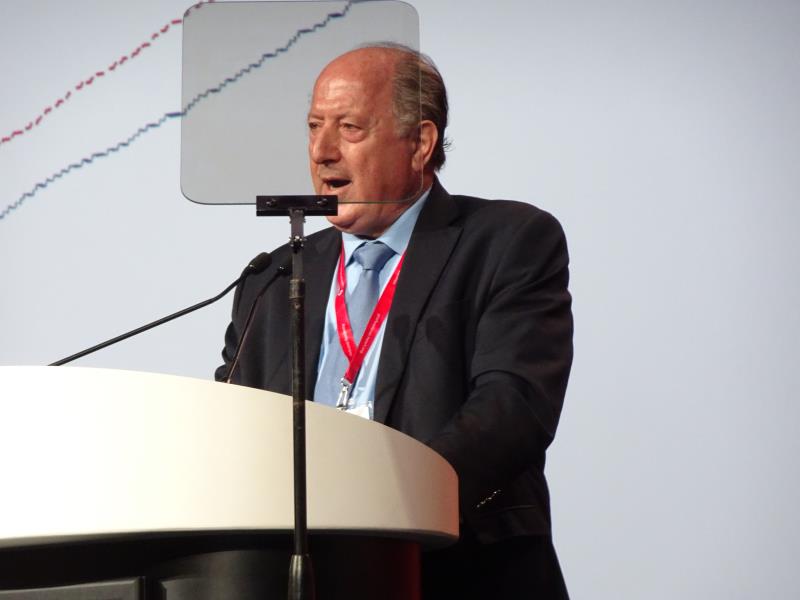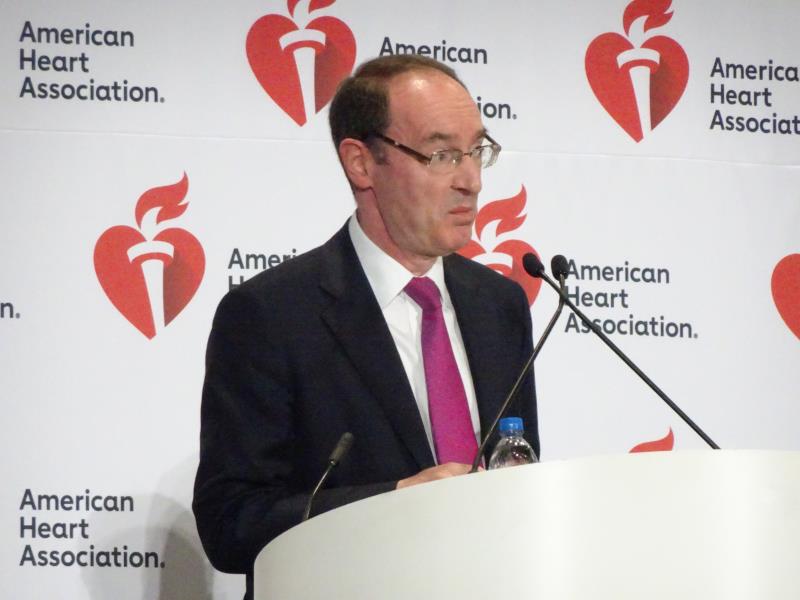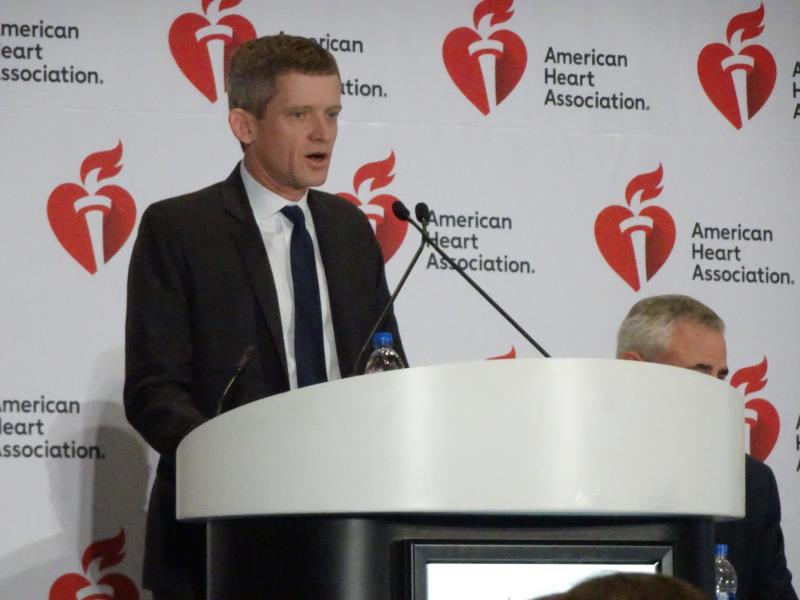 Professor Felipe Martinez
Professor Felipe MartinezMultiple analyses of the DAPA-HF* trial have shown that dapagliflozin, in addition to standard therapy, reduces the risk of multiple heart failure (HF) outcomes including cardiovascular (CV) death and hospitalization for HF (HHF) in patients with HF and reduced ejection fraction (HFrEF), with the effects consistent regardless of age and type 2 diabetes (T2D) status.
“The DAPA-HF results confirmed and extended the prior defined HF results,” said Professor Carolyn Lam from the National Heart Centre Singapore, who discussed the age- and quality of life (QoL) findings at AHA 2019.
“Dapagliflozin meets the three critical goals of HFrEF management – patients die less, are hospitalized less, and feel better, and this is regardless of age and diabetes status,” she said.
 Professor Carolyn Lam
Professor Carolyn LamRisk reduction irrespective of age
In a post hoc analysis of DAPA-HF, the reduced risk of the primary outcome (CV death, HHF, and urgent HF visit) with dapagliflozin (10 mg QD) vs placebo** was consistent in all age groups (hazard ratio [HR], 0.87, 0.71, 0.76, and 0.68 in patients aged <55 years, 55–64 years, 65–74 years, and ≥75 years, respectively; pinteraction=0.76). [AHA 2019, LBS 5]
This consistency applied to separate outcomes including CV death, HHF or urgent HF visit, and all-cause death (pinteraction=1.00, 0.99, and 1.00, respectively). The clinically meaningful improvement (≥5 points) in KCCQ-TSS*** at 8 months was also consistently in favour of dapagliflozin over placebo in all age groups. Serious adverse event (AE) incidence was also similar across age groups and discontinuation was infrequent.
According to Professor Felipe Martinez from the Cordoba National University, Cordoba, Argentina, who presented the results, HF incidence in the elderly population is increasing and patients with HF in regions such as Latin America, Africa, and Asia are often younger than those in North America and Western Europe.
Additionally, tolerability to medications is a concern in the elderly population due to advanced age, comorbidities, and polypharmacy. Therefore, understanding the efficacy and safety of new treatments across age groups is crucial, he said.
“The relative and absolute risk reductions in death and hospitalization were substantial and clinically important. The absolute benefits in older patients were large because they were at higher risk than younger patients,” said Martinez. “Dapagliflozin offers a new approach to the treatment of HFrEF, irrespective of age.”
“The benefit to risk profile of dapagliflozin is as favourable in older as in younger patients,” echoed Lam. “Older patients were less likely to be aggressively treated with guideline-directed medical therapy which may have amplified the benefit of dapagliflozin but also suggests therapeutic inertia,” she noted.
Consistent QoL outcomes
With regard to QoL, patients in all three tertiles of KCCQ-TSS at baseline (≤65.6, 65.7–87.5, and >87.5) experienced a greater reduction in the primary outcomes with dapagliflozin vs placebo (pinteraction=0.52). [AHA 2019, LBS 5]
When the effects of dapagliflozin were stratified by KCCQ tertiles, there was no evidence of treatment heterogeneity and there was consistent benefit with dapagliflozin regardless of whether symptom impairment was mild, moderate, or severe at baseline, said Professor Mikhail Kosiborod from the University of Missouri-Kansas City, Missouri, US.
Mean KCCQ-TSS scores at 4 and 8 months were significantly greater with dapagliflozin vs placebo (mean difference, 1.91 [4 months] and 2.76 [8 months]; p<0.0001). This superiority pertained to both KCCQ clinical summary score (includes physical limitations; mean difference, 1.80 and 2.55 at 4 and 8 months, respectively) and KCCQ overall summary score (includes social limitations; mean difference, 1.74 and 2.31, respectively; p<0.0001 for all).
Greater improvements in KCCQ scores were associated with greater benefits with numbers needed to treat of 14, 15, and 18 with ≥5-, ≥10-, and ≥15-point improvements in KCCQ scores.
“There are two key objectives or goals of care in patients with HFrEF. The first is to reduce death and hospitalizations but the second and equally important goal is to improve health status which means improving symptoms, physical limitations, and QoL,” said Kosiborod.
Dapagliflozin offers a new approach to improving these outcomes, he said. “Fewer dapagliflozin-treated patients had significant deterioration, and more experienced small, moderate, and large clinically meaningful improvements across all key domains of KCCQ.”
 Prof John McMurray
Prof John McMurrayImprovements regardless of T2D status
Of the 4,744 patients with HFrEF in the DAPA-HF trial, 2,139 and 2,605 patients did and did not have T2D, respectively. Compared with patients with T2D, those without T2D were less likely to have ischaemic aetiology (51 percent vs 62 percent) or chronic kidney disease (eGFR <60 mL/min/1.73 m2; 36 percent vs 46 percent). Background medical therapy was comparable between those with and without T2D.
Dapagliflozin reduced the risk of the primary outcome both in patients with T2D (HR, 0.75) and without T2D (HR, 0.73; pinteraction=0.80). [AHA 2019, LBS 1]
This risk reduction in patients with and without T2D applied to both CV death (HR, 0.79 and HR, 0.85, respectively; pinteraction=0.70) and worsening HF events (HR, 0.77 and HR, 0.62, respectively; pinteraction=0.23).
The reduction in outcomes with dapagliflozin was also consistent in patients with and without T2D with regard to CV death and total HHF which included first and repeat hospitalizations (rate ratio [RR], 0.77 and 0.73, respectively; pinteraction=0.74), a ≥5-point change in KCCQ-TSS (pinteraction=0.74), worsening renal events (HR, 0.73 and 0.67, respectively; pinteraction=0.86), and all-cause death (HR, 0.78 and 0.88, respectively; pinteraction=0.45).
The rate of treatment discontinuation was low in patients with and without T2D.
“The relative and absolute risk reductions in death and hospitalization were substantial, clinically important, and consistent in patients with and without T2D,” said Professor John McMurray from the University of Glasgow, Glasgow, UK. “Dapagliflozin is an effective treatment for HF irrespective of whether patients have T2D,” he said.
“These results were essentially independent of HbA1c,” pointed out Professor Larry Allen from the University of Colorado, Aurora, Colorado, US, who discussed the results. He highlighted that the effects of dapagliflozin in patients without T2D was one of the primary goals of the DAPA-HF trial which was specifically designed to have at least 50 percent of participants without T2D.
“Patients with HFrEF, irrespective of their HbA1c, should be considered for an SGLT2# inhibitor,” he added, noting that timing of introduction of this drug needs to be established.
 Prof Larry Allen
Prof Larry AllenUnanswered questions
Lam noted that as the age- and QoL findings were results of post hoc and secondary analyses of a single trial, it remains uncertain if the findings are drug specific or a class effect. The generalizability of the findings to real world situations, and in other patient subgroups such as those with HF and preserved ejection fraction, and the effects of dapagliflozin in combination with angiotensin receptor neprilysin inhibitors, are as yet unknown.
“These studies provide further important data, which if confirmed in other trials of SGLT2 inhibitors in HFrEF, support SGLT2 inhibition as the next foundational pillar of HFrEF treatment,” she concluded.